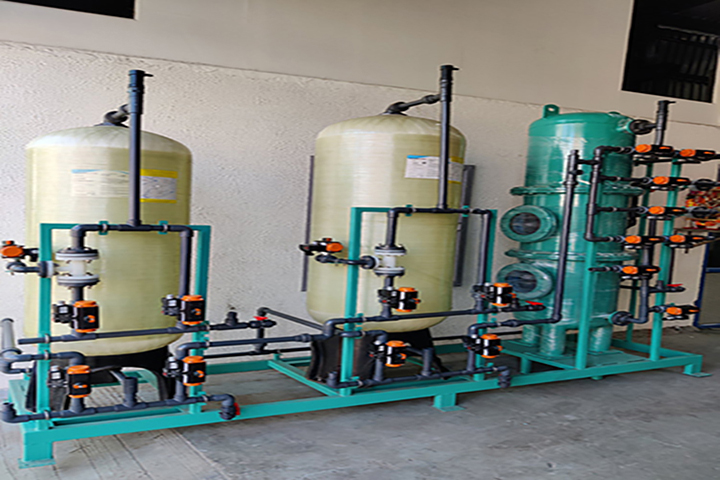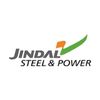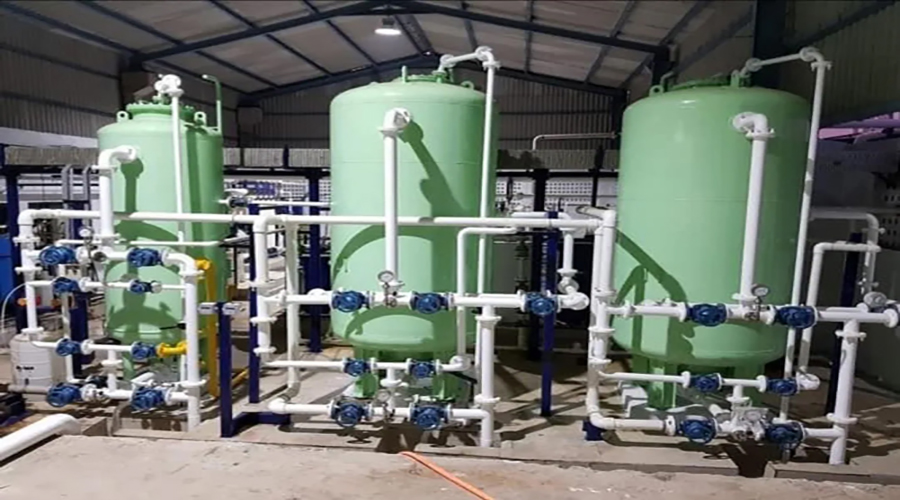DM Plant Manufacturer
Demineralization Plant (DM Plant)
A Demineralization Plant (DM Plant) is a vital water treatment system to eliminate dissolved minerals, salts, and ions. This purification is achieved through ion exchange, which typically employs cation and anion exchange resins. These specialised resins effectively swap undesirable ions present in the water with hydrogen and hydroxyl ions. This exchange results in high-purity demineralised or deionised water with low conductivity and minimal mineral content.
DM plants find widespread application across various industries where water quality is paramount. They are crucial in preparing boiler feedwater, preventing scale formation and ensuring efficient operation. The electronics manufacturing sector relies on deionised water to avoid contamination in sensitive processes. Similarly, pharmaceutical production demands water free from impurities to maintain the integrity of medications. DM plants provide the high-quality water necessary for many critical industrial processes and applications.
Why Opt for Hydroflux Engineering?
Select Hydroflux Engineering for its specialised knowledge in DM plant manufacturing and services. They offer innovative and cost-effective solutions, demonstrating a strong commitment to providing superior demineralised water systems customised for diverse industrial needs.

Our Strengths:
- Innovative Solutions: Employing cutting-edge technologies for optimal water purification.
- Tailored Solutions: Designing systems to meet specific client requirements precisely.
- Reliable Technology: Utilising proven and dependable components for consistent performance.
- Efficient Treatment: Ensuring effective removal of impurities for high-quality water.
How Does a DM Plant Operate?
The core of a Demineralization Plant (DM Plant) lies in the process of ion exchange, effectively stripping dissolved minerals from the incoming water. Initially, the water stream is directed through beds containing cation exchange resins. Here, positively charged ions in the water, such as calcium and magnesium, are exchanged for hydrogen ions held by the resin.
The partially treated water flows through anion exchange resin beds following the initial exchange. In this stage, negatively charged ions like chloride and sulfate are replaced with hydroxide ions. The hydrogen ions from the cation exchange and the hydroxide ions from the anion exchange combine to form pure water.
The final output of this two-stage process is demineralised or deionised water. This purified water exhibits low electrical conductivity and minimal mineral content, making it ideal for critical industrial applications. These include supplying feedwater for high-pressure boilers, ensuring contaminant-free processes in electronics manufacturing, and providing pure water for pharmaceutical production.
How Can We Assist with Your DM Plant Needs?
We offer end-to-end support for your Demineralization Plant (DM Plant) projects, beginning with a detailed evaluation of your requirements. Our initial step involves a comprehensive analysis of your source water quality, production demands, and all relevant regulatory standards to clearly understand your unique situation.
Drawing upon this thorough assessment, our team of experts recommends the most appropriate DM technologies for your application. We carefully consider various factors, including the effectiveness of ion exchange processes, the potential of membrane technologies, and the necessary plant capacity. We emphasise close collaboration with you throughout this selection process, ensuring tailored solutions and providing expert guidance at every stage.
Our ultimate goal is to guarantee that the final DM Plant design precisely aligns with your operational objectives. We are committed to delivering efficient and sustainable demineralised water solutions that meet your production needs and adhere to all applicable regulatory and environmental demands, ensuring long-term success.
What Are the Various Technologies Employed in DM Plants?
Here are the different types of Demineralization Plant (DM Plant) technologies:
- Ion Exchange: This method relies on specialised resins to swap unwanted positively charged ions (cations) and negatively charged ions (anions) in the water with hydrogen and hydroxyl ions, effectively removing dissolved minerals.
- Reverse Osmosis (RO): Utilising pressure, this technology forces water through semi-permeable membranes, effectively filtering out dissolved ions and other impurities to produce high-purity demineralised water.
- Electrodialysis (ED): This process employs an electric field to selectively transport ions across ion exchange membranes, separating them from the water and yielding demineralised output.
- Electrodeionization (EDI): A sophisticated technique that integrates ion exchange resins with an electric current to continuously remove ions, utilising ion exchange membranes to achieve a highly purified water stream.
- Membrane Capacitive Deionization (MCDI): This electrochemical method uses porous electrodes and ion exchange membranes to attract and remove ions from the water, producing demineralised water.
- Continuous Deionisation (CDI): Similar to EDI, this technology combines ion exchange resins with an electric current to facilitate the constant removal of ions from the water supply.
- Distillation: This traditional method involves boiling water and condensing the resulting steam. Dissolved minerals and impurities are left behind during boiling, yielding demineralised water upon condensation.
Each of these technologies presents distinct advantages and can be chosen based on specific water quality characteristics and the desired level of treatment for various demineralisation applications.
Frequently Asked Questions (FAQ)
Our Clients Testimonials
Our clients consistently commend our high-quality manufacturing and the effectiveness of our wastewater treatment services, encompassing STP, ETP, WTP, Industrial RO, Softener, OWC, and more, delivering exceptional results.
Hydroflux provided an STP system for one of our large residential projects. The plant has been running smoothly, and we’re reusing treated water for landscaping and flushing. Their team did an excellent job with installation and support.

Ravi Sharma
L&T ConstructionAt our telecom office site, Hydroflux installed a compact RO + WTP system. The system is low-maintenance, efficient, and gives us good water quality. They handled the project professionally.

Rajeev Arora
Airtel Facility TeamHydroflux installed a wastewater treatment system for our manufacturing unit. The plant works as per industrial discharge norms. Their timely service and AMC support have been great.

Meenal Kapoor
Samsung ElectronicsWe required an industrial ETP with a ZLD setup. Hydroflux delivered exactly what we needed. Their design is robust and helps us recycle water back into our process lines.

Anil Deswal
Jindal Steel & PowerOur university uses Hydroflux STP to manage sewage within the campus. The treated water is used for gardening, and the plant is eco-friendly. Their technical team is cooperative and trained our staff well.

Dr. Aftab Khan
Jamia Hamdard UniversityWe used Hydroflux for WTP system installation at one of our metro depots. The water treatment system is reliable and easy to maintain. Their service team is always on time.

Sandeep Malhotra
Delhi Metro Rail Corporation (DMRC)We use Hydroflux’s STP and ZLD solution at our bottling plant. Water reuse and discharge quality have both improved. Their ZLD setup helped us clear compliance smoothly.

Vikram Joshi
Pepsi Bottling Unit (Jai Beverages)We installed a RO plant at our Sikandrabad tiles factory. The system provides consistent water quality for tile processing. Very effective and energy-efficient.

Sanjay Singh
Kajaria CeramicsHydroflux installed a compact STP system at our food production plant. Treated water is reused for utility and cleaning. The system is easy to run and completely odorless.

Poonam Verma
Haldiram’s Production UnitOur Gurgaon residential projects have Hydroflux’s STPs. They help us recycle and reuse water, which supports our green building certifications. We’re satisfied with their support even after handover.

Meena Rathi
Raheja DevelopersHydroflux delivered a 690 KLD STP plant for our township. The plant runs automatically and treats large volumes efficiently. It’s been a valuable addition to our sustainability goals.

Ritesh Goyal
Omaxe LtdWe installed an STP from Hydroflux for our resort. Water from bathrooms and kitchen is now treated and reused in our gardens. The plant is silent and blends into our eco-friendly theme.

Arjun Mehta
Best Western ResortHydroflux installed a small but high-efficiency ETP at our Manesar unit. We’ve had no major issues and water discharge is always within limit. Their service is quick and professional.

Priti Sharma
Donaldson India Filter SystemsWe’re using Hydroflux’s STP in our hotel’s backend operations. The system helps us recycle greywater for flushing. Their setup is clean, quiet, and very effective.

Ramesh Yadav
Radisson HotelsHydroflux supplied a robust ETP system for our Bokaro cement plant. It handles high loads and treats effluent effectively. We’ve seen a clear improvement in compliance and water reuse.

Alok Sharma
Dalmia Bharat CementWe installed a compact RO + WTP setup at our Manesar unit through Hydroflux. It runs quietly and requires very little manual handling. The system is reliable and consistent in water output.

Tanya Mehra
BRADY Company India Pvt LtdHydroflux provided an automated ETP solution at our Vapi facility. The system helps us recycle water and control our wastewater discharge. Their service support is excellent even post-installation.

Ritu Jain
HAVELLS IndiaAt our printing unit, Hydroflux installed a RO plant to ensure water quality for ink processing. The plant has reduced scale issues and improved equipment life. It was a great decision to go with them.

Saurabh Chawla
Dainik BhaskarHydroflux provided an MBR-based STP for our Gurgaon campus. The treated water is clear and odorless, perfect for reuse. We are happy with their engineering and service quality.


